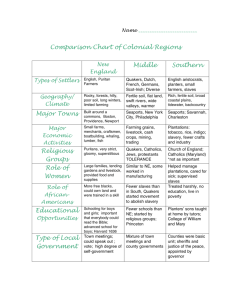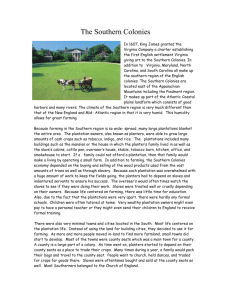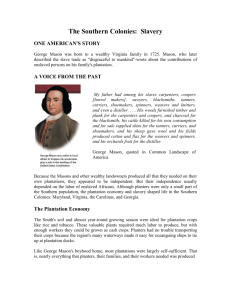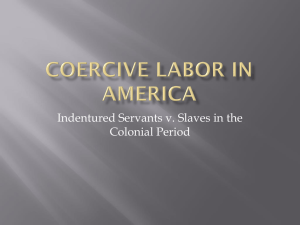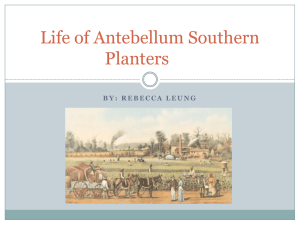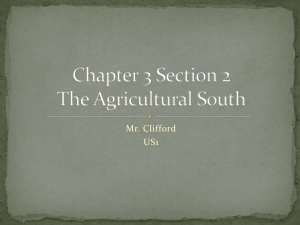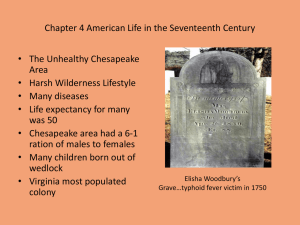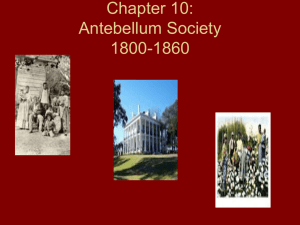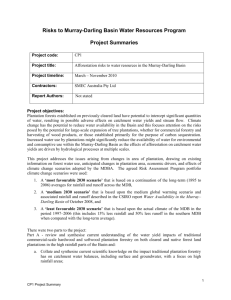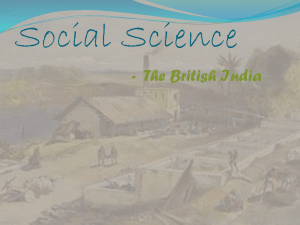Ch. 4 Section 2
advertisement
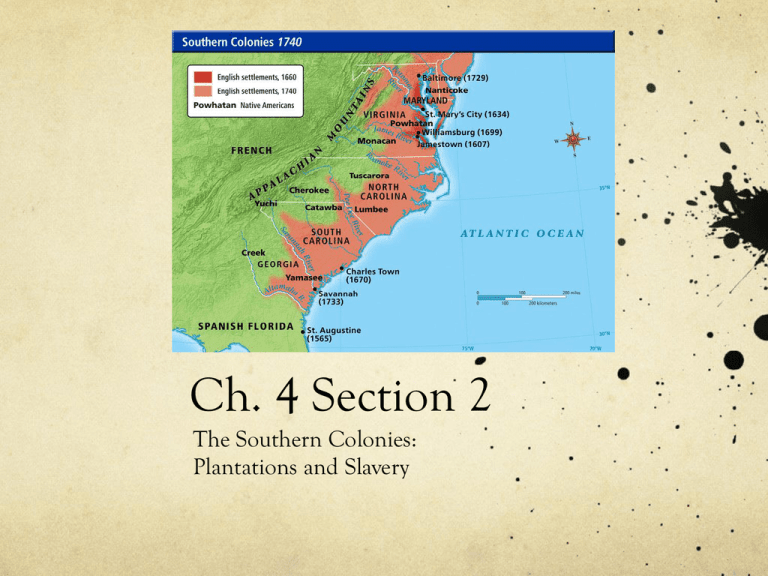
Ch. 4 Section 2 The Southern Colonies: Plantations and Slavery 1. Where were most of the early plantations located? •The Tidewater 2. Where is the tidewater? •Flat land along coast 3. a. What are “cash crops”? •Crops raised to be sold for money b. What “cash crops” were grown in southern plantations? •Rice, tobacco, indigo 4. What was needed to grow these cash crops? •Labor- enough workers to produce them 5. Why weren’t there many large urban centers (cities) in the South? Plantations were self-sufficient (produced most of the things they needed right on the plantations) 6. a. Who were the “elite” in the South? •Plantation owners b. What did they control? •Were like nobility in other countries Political and economic power 7. Fill in the class system pyramid: (Planters) Poor Freemen (Indentured Servants) Slaves 8. What caused many of the early conflicts in the South? •Desire for more land and wealth 9. Who controlled the Tidewater region? •Rich planters 10. a. Where did poorer freemen settle? •Western frontier a. Who did they have to fight for this land? •Native Americans 11. What did Nathaniel Bacon and other landless frontier settlers complain about? •High taxes •Favoritism toward large plantation owners 12. What did Bacon want? •Help fighting the Native Americans at the frontier settlements 13. What happened as a result of Virginia Governor William Berkeley refusing to help frontier settlements against Native Americans? •Bacon’s Rebellion (1676) •Bacon took control of the House of Burgesses and burned down Jamestown to the ground. 14. How did the House of Burgesses strengthen colonists’ rights after Bacon’s Rebellion? • They passed laws limiting the powers of the royal governor. 15. Why did tensions develop between Tidewater and frontier settlers? •Rich vs. Poor •The frontier settlers resented the rich planters of the coast (Tidewater) and their control of the government. 16. What caused a shortage of workers in the 1660s? •White indentured servants finished their terms of service and fewer laborers were moving to the Southern Colonies. 17. Why didn’t the planters use Native Americans as slaves? •They died of diseases brought by Europeans. •They were also able to escape because they knew the area well. 18. Why did southern planters turn to slavery? They needed cheap labor for plantations Couldn’t find enough indentured servants 19. How did the growing number of slaves affect southern laws? Laws were passed to define slavery and to control slaves 20. Who watched over and directed the work of the slaves? Overseers 21. What happened if the slaves didn’t look like they were doing their jobs? They were whipped. 22.What happened if they defied their masters? They were tortured or mutilated. 23. Why did planters seek out slaves from West Africa? They had the skills needed to grow rice. 24. a. What was indigo? A plant that produces blue dye b. Who introduced it as a cash crop? Eliza Lucas 25. How did African Americans resist enslavement? •Worked slowly •Damaged goods •Rebelled •Carried out orders incorrectly •Pretended not to understand orders 26. What happened as a result of slave uprisings like Stono Rebellion? Planters made stricter slave codes: •Slaves were forbidden to leave plantations without written permission •Illegal for slaves to meet free blacks 27. The Northern and Southern Colonies developed into distinct regions. List ways they were different. Complete the chart. South North Large slave populations Diverse economy Plantation economy – based on cash crops (i.e., tobacco, rice, indigo) Wealth more evenly distributed Less diverse The wealth concentrated in the hands of an elite (planters) Scattered settlements, few towns Self-sufficient plantations Smaller farms Larger, more numerous towns

